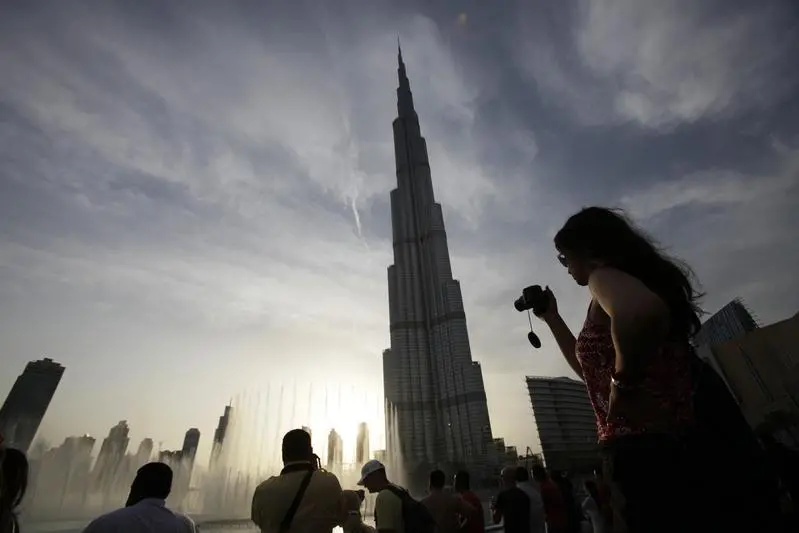PHOTO
A tapering of demand will lower earnings in Dubai's tourism and hospitality industry this year, though an expected rise in arrivals from emerging markets, in particular Asia, may offset weaker traffic from more established sources of visitors.
The fall in the price of oil is being seen as a key factor in weakening demand, with the Russian market one of the hardest hit. The continued weakness of many eurozone countries has also affected Dubai's arrival figures, though it is expected some of this may be offset by increases from developing markets, such as China.
Growth rate slowingSentiment within the industry remains positive, despite the slowdown in growth, according to a recent survey. The Dubai Economy Tracker - a new study of economic conditions within the emirate − showed that business activity dropped in April to its lowest point since October 2013, with the travel and tourism sector the largest drag on growth. The survey, conducted by banking group Emirates NBD and financial information services firm Markit, indicated that the travel and tourism sector index dropped to 52.3 in April, from 55.5 in March.
Khatija Haque, head of MENA research at Emirates NBD, said sectors such as construction and retail showed relatively robust growth, but the tourism sector was negatively impacted by a number of factors such as a stronger US dollar hurting key emerging markets.
A weakening in markets such as Russia has added to the sector's woes. Lower oil prices and the impact of sanctions imposed over its involvement in the Ukraine conflict have seen the value of the rouble tumble, meaning fewer Russians can afford to travel and those that do may have less to spend. Last year saw a 23.5% year-on-year decline in Russian visitors and the ongoing easing in arrivals from that country and other members of the Commonwealth of Independent States will continue to eat into booking levels.
Offsetting this though has been a steady rise in arrivals from new markets, such as China, which Dubai has been working to develop in recent years, both through promotional activities and by providing services catering to Chinese visitors. "We have dedicated Chinese websites and dedicated Chinese content ... it's a market that's going to continue to grow in importance and we take it very seriously" said the Director General of Dubai's Department of Tourism and Commerce Marketing (DTCM), Helal Saeed Almarri.
The strategy is paying off, with a 25% jump in arrivals from China in 2014, with inbound visitors topping the 340,000 mark, according to local media reports. This increase compares to an overall rise of 8.2% in arrivals last year, with the DTCM forecasting expansion of 7-9% this year, with India, China and South-east Asia among identified growth markets.
Rev below PARThe expected fall in arrivals from key markets is also set to impact hotel earnings, compounded by new offerings coming to the market. A PwC report issued in May forecasts a 2.4% fall in revenue per available room (RevPAR) to $184.6 this year, as occupancy and average daily rates ease (ADR). RevPAR edged up 0.5% year-on-year in 2014, which missed the consultancy's forecast of a 6.5% increase. Other estimates put last year's RevPAR figure down 2.3% year-on-year, from a record high in 2013, according to real estate consultancy JLL.
The PwC report added that many of the factors affecting Dubai's tourism sector in 2014 such as lower visitor numbers from Russia and the CIS, high levels of room stocks and concerns over the euro, would continue this year. "In the interim it will mean that supply − or more accurately oversupply − could become an issue in some parts of the region, especially at the increasingly crowded luxury end of the market," the report concluded.
According to JLL, the average increase in hotel rooms was 5% per year from 2009-2014, with this rate set to increase to 12.5% annually until 2017 based on existing project pipeline and forecasts. Having opened 2015 with 65,000 graded rooms, Dubai could see another 21,000 new rooms added to the existing stocks by the end of 2017.
However, the picture is looking brighter with PwC forecasting a 6.6% rise in RevPAR to $196.8 in 2016 thanks to improved occupancy and ADR driven by infrastructure spend, moderate supply increases and higher tourist numbers. A rebound in the global tourism trade will also help absorb additional accommodation supply over the coming years.
© Oxford Business Group 2015












